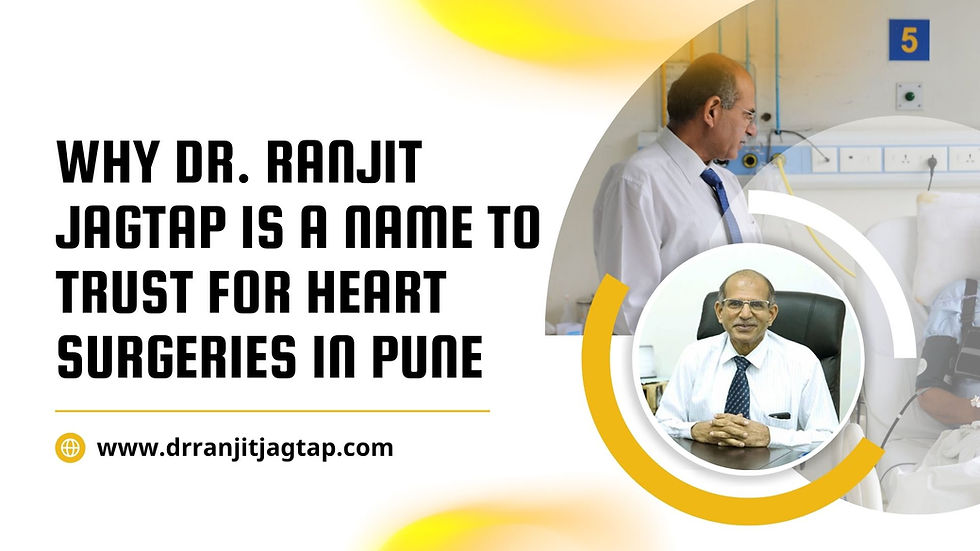WHAT IS OPEN HEART AORTIC VALVE SURGERY AND HOW DOES IT WORK?
- drranjitjagdap
- Oct 14, 2021
- 3 min read
Updated: Mar 7, 2022
Heart surgeons do aortic valve surgery to treat bicuspid valves, various congenital aortic valve disorders, and aortic valve stenosis. A valve's flaps can thicken, harden, or fuse together. As a result, the valve cannot fully open and aortic valve regurgitation occurs when the left ventricle relaxes, causing blood to seep through the aortic valve. Blood can flow in both directions through a leaky (or regurgitant) aortic valve. The heart's workload is increases as a result, predisposing it to failure.
SURGERY ON THE AORTIC VALVE
Aortic valve surgery has two types: aortic valve repair and aortic valve replacement.
The findings of your diagnostic tests, the anatomy of your heart, your age, the existence of other medical issues, as well as other considerations are the signs to go for aortic valve replacement. Traditional heart valve surgery or less invasive techniques conducts aortic valve surgery at Ram Mangal Heart Foundation by Dr Ranjit Jagtap.
SURGERY OF THE AORTIC VALVE IN THE TRADITIONAL WAY
A surgeon creates a 6- to 8-inch incision through the middle of your sternum. Then part or all of the sternum (breastbone) separates to enable direct access to your heart during conventional aortic valve surgery.
AORTIC VALVE SURGERY WITH MINIMAL INVASIVENESS
Minimally invasive aortic valve surgery is a type of aortic valve repair surgery that uses tiny, 2- to 4-inch incisions rather than a full chest opening. This is usually a "J" incision, which leaves your chest stable. Minimally invasive surgery lowers blood loss, trauma, hospitalisation time, as well as recovery time.
The majority of patients who require isolated aortic valve surgery are candidates for minimally invasive aortic valve surgery, but your surgeon will check your diagnostic tests to see whether you are.
AN ENLARGED AORTA REPAIR
Aneurysms of the ascending aorta, the first section of the aorta, has a frequent link with aortic valve dysfunction (the main blood vessel in the body that originates from the aortic valve).
Replace this section of the aorta if the expansion is significant. This takes place when the aortic valves go for repairing and replacement. A unique operation can be done on individuals who have a leaking aortic valve and an enlarged aorta. The technique allows surgeons to replace the enlarged ascending aorta while also repairing the aortic valve.
REPLACEMENT OF THE AORTIC VALVE
Your surgeon may replace the valve if valve repair is not a possibility. Dr Ranjit Jagtap daughter, Aditi Jagtap, works at the Ram Mangal Heart Foundation as part of a larger recovery team. She offers emotional support as well as physical recovery treatment to patients.
REPLACEMENT OF MECHANICAL VALVES
Mechanical valves are entirely formed of mechanical pieces that are non-reactive and well tolerated by the human body.
To limit the risk of blood clotting and stroke, all patients with mechanical valve prosthesis must take an anticoagulant drug for the remainder of their lives. This might make you more prone to bleeding. You can avoid it by keeping a close eye on a blood parameter called PT/INR.
BENEFITS AND RISK
Aortic valve surgery is frequently required when there is no other alternative except to treat a damaged valve that is causing cardiac dysfunction and failure.
Before the heart decompensates, surgery should take place. In some cases, the advantages clearly exceed the hazards. Heart failure and cardiomyopathy develop as we age, increasing the risks connected with surgery.
Individual risk is influenced by previous heart surgery, age, co-existing organ illness. These are such as emphysema, renal disease, past history of stroke or ischemic heart disease, etc. These necessitate surgical treatment. Your surgeon will go through the surgical risks with you.
Several cardiac surgeries take place at the Ram Mangal Heat Foundation, with Aditi Jagtap Pune in charge of the administrative aspect of health care. She also ensures that a medical institution is employing effective and efficient practises. They provide the finest possible treatment for the patients.





Comments